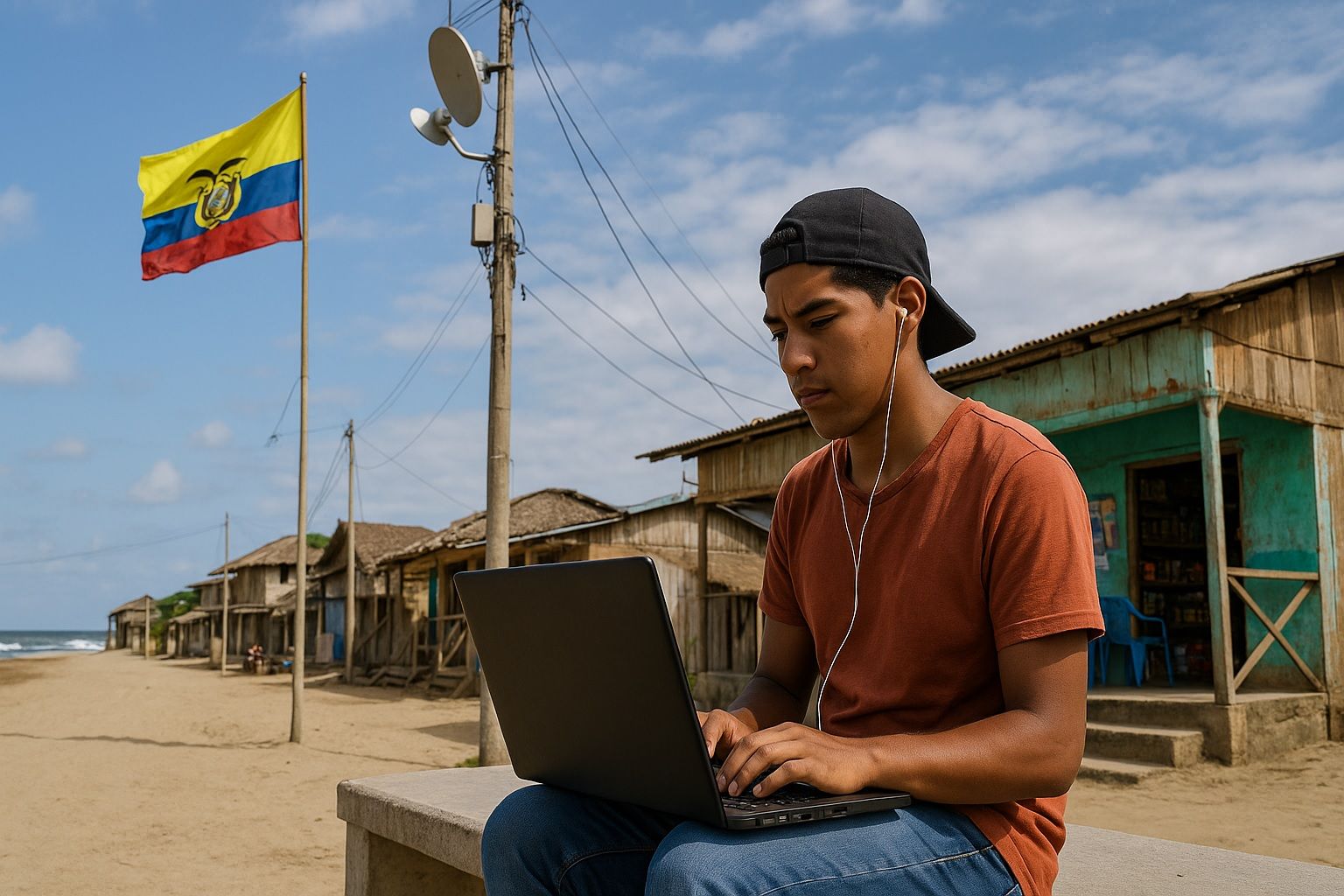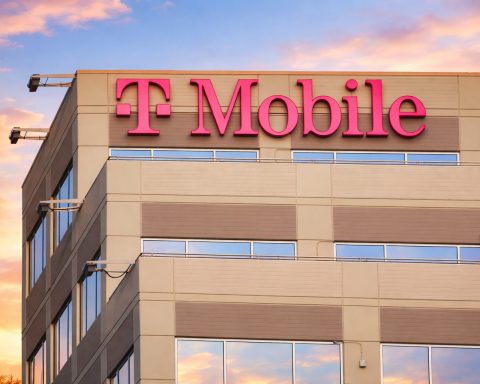- Fixed broadband penetration is around 15% of the population as of December 2022, equating to roughly 2.75–2.9 million fixed broadband accounts in a country of 18 million people.
- About 20,242 km of fiber-optic cable were laid in 2022 alone, representing nearly 10% of Ecuador’s total fiber infrastructure.
- The Mistral undersea cable was activated to increase international bandwidth, in partnership with América Móvil (Claro) and Telxius, with planned Galápagos subsea cable and Carnival Submarine Network to link Ecuador to the United States.
- By January 2023, Ecuador had 16.7 million active mobile connections (roughly 92% of the population) and about 10.8 million mobile internet subscriptions (roughly 57% of the population).
- Total mobile line users reached 17.8 million and cellular penetration stood at 97.8% of the population as of May 2023.
- 4G LTE coverage reaches about 78% of the population, while 2G/3G signals cover approximately 98%.
- Public connectivity includes 886 Meeting Points centers as of January 2023, with 185 centers in the Amazon region, and about 1.7 million people have benefited from free internet and digital training.
- There were 6,775 free public Wi‑Fi hotspots across 20 provinces by early 2023, and Quito announced in 2023 a program to install 1,500 free Wi‑Fi hotspots throughout the city by 2024.
- The urban–rural divide remains, with 70.1% of urban households having internet at home in mid-2022 versus 38.0% of rural households, and 78.5% of urban residents using the internet compared with 50.5% in rural areas in 2022.
- Starlink launched in April 2023, with Galápagos coverage first, mainland rural orders beginning mid-2023; typical speeds range from 50–200 Mbps with latency of 20–40 ms, while monthly cost is around $60 and a hardware kit about $355, and HughesNet continues to operate in Ecuador via geostationary satellites.
Ecuador’s internet infrastructure is a mix of fixed broadband networks, expanding mobile coverage, and a growing number of public Wi-Fi access points. Fixed broadband penetration remains relatively low – around 15% of the population had a fixed-line internet subscription as of late 2022 [1]. This equated to roughly 2.75–2.9 million fixed broadband accounts in a country of 18 million people [2] [3]. However, the country has been rapidly expanding its fiber-optic footprint: about 20,242 km of fiber-optic cable (nearly 10% of the nation’s total fiber infrastructure) was laid in 2022 alone to improve broadband capacity [4]. Additionally, Ecuador recently boosted its international connectivity by activating the new Mistral undersea cable, in partnership with América Móvil (Claro) and Telxius, to increase bandwidth. Further projects – including a dedicated Galápagos subsea cable and the Carnival Submarine Network linking Ecuador to the United States – are planned in the coming years [5], which will strengthen the backbone of Ecuador’s internet infrastructure.
Mobile internet is the primary mode of access for most Ecuadorians and has far greater reach than fixed lines. By early 2023 there were about 16.7 million active mobile cellular connections, roughly 92% of the population [6]. Of these, approximately 10.8 million were mobile internet subscriptions, representing about 57% of the population with mobile data service [7]. In total, the mobile sector served 17.8 million mobile line users (including voice-only users), pushing cellular penetration to 97.8% of the population as of May 2023 [8]. Ecuador’s mobile networks currently rely on 3G and 4G LTE technology – 4G coverage reaches about 78% of the population, while basic 2G/3G signals cover nearly 98% [9]. Median mobile download speeds were around 18–21 Mbps as of early-to-mid 2023 [10] [11], indicating a moderate mobile broadband quality that has been gradually improving. The country has yet to launch 5G commercially, but the telecom regulator is laying groundwork for future 4G and 5G spectrum allocations (more on this in a later section) [12].
Public Wi-Fi and community access points form an important part of Ecuador’s connectivity strategy, especially to serve those who lack home or mobile internet. The government has established hundreds of community technology centers – originally called “Infocentros” and now rebranded as “Puntos de Encuentro” (Meeting Points) – in rural and peri-urban areas. As of January 2023, there were 886 such centers providing free internet access and digital training, including 185 centers in the Amazon region alone [13]. These facilities, often equipped with computers and staffed to offer digital literacy courses, have benefitted an estimated 1.7 million people by offering free connectivity and IT workshops in underserved communities [14]. In addition, the government reported 6,775 free public Wi-Fi hotspots spread across 20 provinces by early 2023 [15]. Many of these Wi-Fi access points are installed in parks, libraries, transportation hubs, and other high-traffic or remote locations to provide basic internet access at no cost to users. For example, the municipal government of Quito launched a program in 2023 to install 1,500 free Wi-Fi hotspots throughout the capital city’s public spaces, slated for full deployment by 2024 [16]. These public Wi-Fi initiatives are helping to bridge connectivity gaps for those who cannot afford private internet service or live in areas where commercial broadband is unavailable.
Table 1: Fixed vs. Mobile Internet Access in Ecuador (2023)
| Indicator | Value (Ecuador) | Notes |
|---|---|---|
| Fixed broadband subscriptions | 2.75 – 2.90 million (Dec 2022) | ~15% of population [17]. |
| Active mobile connections | 16.7 million (Jan 2023) | ~92% of population [18]. |
| Mobile internet users | ~10.8 million (Mar 2023) | ~57% of population [19]. |
| Overall internet users | 14.7 million (Jan 2023) | ~81.3% of population [20]. |
| 4G LTE coverage | 78% of population (2023) | Remainder on 2G/3G [21]. |
| Median download speed – Mobile | ~19 Mbps (early 2023) | Continues to improve [22]. |
| Median download speed – Fixed | ~46–56 Mbps (early–mid 2023) | Up ~44% vs. 2022 [23] [24]. |
Sources: ARCOTEL, MINTEL, Digital 2023 Report [25] [26] [27] [28].
Urban–Rural Digital Divide
Despite the expanding infrastructure, significant inequalities in internet access persist between Ecuador’s urban and rural populations. The data shows a clear and widening digital divide. In mid-2022, about 70.1% of urban households had internet access at home, compared to only 38.0% of rural households [29]. Just two years earlier (2020), those figures were 61.7% urban vs. 34.7% rural [30], indicating that while connectivity has improved in both contexts, the gap between cities and countryside remains large. In fact, there is evidence the divide has widened in terms of individual usage: the share of people living in urban areas who use the internet in some capacity edged up to 78.5% in 2022 (from 77.1% in 2020), whereas in rural areas the proportion of individuals using the internet actually fell from 56.9% to 50.5% over the same period [31]. This counterintuitive decline in rural internet use may reflect persistent obstacles such as affordability and lack of reliable service, which prevented new users from coming online or even led some to drop offline.
Geography plays a big role in these disparities. Ecuador’s most underserved communities are found in the Amazon rainforest region, the remote southern highlands, parts of the Pacific coast, and the distant Galápagos Islands, all of which have lacked sufficient telecom infrastructure historically [32]. According to the Ministry of Telecommunications, as of 2022 roughly 25% of rural parishes (administrative districts) had no internet connectivity at all [33]. By contrast, the main cities and their provinces enjoy far better coverage: the two most populous provinces, Pichincha (home to Quito) and Guayas (home to Guayaquil), together accounted for 58% of all internet subscriptions in the country as of December 2022 [34]. In other words, fixed and mobile subscriptions are heavily concentrated in the urban core areas, highlighting the lopsided distribution of digital access.
There are also socio-demographic inequalities intertwined with the urban–rural gap. Indigenous and Afro-Ecuadorian communities, who are disproportionately rural and economically disadvantaged, have lower levels of connectivity. As of mid-2022, an estimated 70.5% of Indigenous households, 55.4% of Montubio (coastal farming community) households, and 46.3% of Afro-Ecuadorian households did not have internet access at home – rates of exclusion much higher than for mestizo (mixed-heritage) households (34.5% without access) [35]. These figures illustrate that digital inequality in Ecuador is not only geographical but also correlates with ethnicity and income. Households in rural villages, many of which are Indigenous or Afro-descendant and engaged in subsistence agriculture, often cannot get or afford a broadband connection, whereas most urban mestizo families are now online. This digital divide risks exacerbating existing social inequalities, as those without internet access face barriers to information, services, and economic opportunities.
To visualize the gap, the table below summarizes recent data on internet access by location:
Table 2: Internet Access in Urban vs. Rural Ecuador
| Population Segment | Households with Internet (2022) | Individuals Using Internet (2022) |
|---|---|---|
| Urban areas | 70.1% [36] | 78.5% [37] |
| Rural areas | 38.0% [38] | 50.5% [39] |
Source: National Institute of Statistics (INEC) via MINTEL [40] [41]. (Note: “Using Internet” refers to individuals who reported using the internet, from any location, in the past year.)
The implications of this urban–rural digital divide are far-reaching. Rural students and workers often lack the reliable internet needed for online education or e-commerce, putting them at a disadvantage. Many rural residents must travel to towns or community Wi-Fi centers just to get online. The government acknowledges this gap as a serious issue and has been investing in solutions (outlined in the next section). Yet challenges such as difficult terrain, sparse populations, and poverty continue to impede equal internet access. Bridging this divide will require sustained efforts in infrastructure deployment, affordability, and digital literacy to ensure that Ecuador’s digital frontier is inclusive of its most remote and marginalized communities.
Government Initiatives and Regulatory Framework
The Ecuadorian government – through its Ministry of Telecommunications and Information Society (MINTEL) and regulatory agencies – plays a central role in advancing internet penetration and digital inclusion. In recent years, the government has launched plans and invested in programs to extend connectivity to underserved areas. For example, the national “Plan for the Creation of Opportunities 2021–2025” explicitly set targets to expand coverage of advanced mobile networks: it aims to increase 4G/LTE (and newer technology) coverage from about 60.7% of the population in 2021 to 92% by 2025, focusing on rural and remote expansions [42]. This is part of a broader Digital Transformation Agenda (2022–2025) that coordinates efforts to improve infrastructure, e-government, and digital skills [43].
One of the government’s flagship efforts has been the support of community connectivity centers and public Wi-Fi, as noted earlier. By rebranding Infocentros to “Meeting Points”, President Guillermo Lasso’s administration sought to modernize these hubs and partner with private companies to offer training and services [44]. MINTEL reported investing nearly $10 million between 2021 and 2022 to provide 4G mobile coverage in 53 previously unserved parishes, benefiting ~332,000 people [45]. Thanks to such investments, the government announced that by 2023 it expected to cover 85% of the population with 4G or better mobile signals [46]. In addition, as mentioned, thousands of free Wi-Fi hotspots have been set up nationwide with government support [47]. These initiatives demonstrate a clear policy emphasis on narrowing the connectivity gap (particularly for rural and low-income groups) through public investment and partnerships.
Ecuador’s telecommunications regulatory body, the Agency for Regulation and Control of Telecommunications (ARCOTEL), has been actively updating the regulatory framework to foster improved services and competition. Under former President Lasso, efforts were made to modernize telecom regulations and attract new players. Notably, spectrum management has been a recent focus: ARCOTEL, with support from the International Telecommunication Union, began reorganizing key frequency bands (3.5 GHz, 2.5 GHz, 700 MHz, and AWS bands) in preparation for future spectrum auctions for 4G/LTE expansion and upcoming 5G networks [48]. As of early 2024, MINTEL had signaled intentions to tender licenses for 5G deployment, though a formal timeline was still pending [49]. The reallocation of these bands – which are crucial for 5G and for extending 4G into rural areas – is expected to pave the way for improved mobile broadband coverage and capacity in the next few years.
Another regulatory development is the promotion of infrastructure sharing and public-private partnerships. Given the high cost of deploying networks in sparsely populated or difficult terrains (like the Andes and Amazon), MINTEL has suggested that sharing towers, fiber backbones, and other infrastructure between operators could help reduce deployment costs and incentivize expansion into rural zones [50]. The regulator also advocates exploring alternative technologies for rural connectivity [51] – a nod to solutions like satellite internet, community networks, or wireless mesh systems to reach areas where traditional fiber or mobile towers are not economical.
In terms of institutions, MINTEL sets the telecom and ICT policy and is responsible for programs like the Meeting Points and spectrum tenders, while ARCOTEL issues licenses, enforces telecom regulations, and monitors market competition and quality of service. The government also established a new Data Protection regulatory framework (with a data protection agency to be appointed) in recent years [52] [53], reflecting a growing attention to the digital rights landscape alongside access expansion. Moreover, Ecuador’s legislature updated the telecommunications law and communications law in 2022 to encourage freedom online and reduce content regulation [54], which, while not directly related to access, shows a trend towards a more open digital environment.
Crucially, the government has recognized that connecting the country means investing in big infrastructure projects. Alongside the aforementioned submarine cables (one linking to the Galápagos and another to the U.S.), the state-owned telecom utility Corporación Nacional de Telecomunicaciones (CNT) has been tasked with expanding the fiber-optic backbone domestically. By boosting backhaul capacity and international bandwidth, Ecuador aims to lower the cost and improve the speed of internet nationwide. In May 2023, MINTEL announced that total telecom sector investment in 2022 hit a record $904 million, of which $885 million (98%) came from the private sector [55]. This indicates a healthy level of private investment under a regulatory climate that is increasingly encouraging competition and network upgrades. The entrance of new players like Google Cloud, Amazon Web Services, and Oracle establishing cloud infrastructure in Ecuador, and SpaceX’s Starlink entering the ISP market (more on that shortly), all in the last couple of years, suggests that government openness to international tech and telecom firms has improved [56].
Overall, Ecuador’s government and regulators are actively trying to modernize the digital ecosystem – balancing acts of incentivizing private investment, updating laws for new technology (like preparing for 5G and satellite broadband), and directly funding inclusion programs. The challenges of regulation include ensuring fair competition (in a market long dominated by a few operators), keeping consumer prices affordable, and enforcing quality standards, especially as new services like satellite internet emerge. Thus far, the regulatory approach has been to welcome new solutions (e.g. quickly authorizing Starlink’s entry) and to push for greater coverage obligations in licensing. The continued commitment to national digital agendas and international best practices (with ITU guidance) reflects an understanding that robust policy and regulation are as vital as cables and towers in closing the digital divide.
Private Sector’s Role in Connectivity
The private sector – notably telecom companies and internet service providers (ISPs) – has been instrumental in Ecuador’s connectivity landscape, both as service providers and as investors in infrastructure. Ecuador’s telecom market is relatively concentrated, with three major operators dominating both mobile and broadband services. These are:
- Claro (América Móvil) – a Mexican-owned company which holds about 52% market share in the telecom sector [57]. Claro is the largest mobile operator and also offers fixed broadband (including fiber) in many cities.
- Telefónica Movistar – a Spanish-owned carrier with roughly 31% market share [58]. Movistar is the second-largest mobile provider and has some presence in fixed internet. In recent years Telefónica has scaled down operations in some Latin countries, but in Ecuador it remains a key player.
- CNT (National Telecommunications Corporation) – the state-owned telecom company, which has around 17% of the market [59]. CNT inherited the infrastructure of the former state telecom monopolies and provides fixed telephone, broadband (ADSL/fiber) and mobile services. CNT’s market share is smaller in mobile, but it is a major fixed broadband provider especially in areas where private companies were slower to deploy.
These three operators together serve essentially all of Ecuador’s ~18 million mobile subscribers and the majority of fixed-line subscribers. For mobile, penetration is near saturation (98% as noted), but for internet use there was still room for growth – much of which the private sector is driving through network upgrades and marketing of data services. Importantly, competition between Claro and Movistar has been a force for expanding 4G coverage and introducing innovations (like more affordable data plans) in urban areas. However, in rural or less profitable areas, competition is limited and coverage often relies on whichever operator had legacy infrastructure (often CNT) or on government-led projects.
In the fixed broadband arena, a number of smaller private ISPs have carved out market niches, sometimes outperforming the big three in certain metrics. For instance, one analysis in 2023 showed an ISP called Megadatos (less well-known internationally) as the largest fixed-line internet provider with over 30% of subscriptions, surpassing CNT’s ~15% share in fixed broadband [60]. Companies like Netlife (a fiber-to-the-home provider), Puntonet, and others have been actively deploying fiber in cities like Quito and Guayaquil, challenging CNT’s older DSL lines. These agile private ISPs often offer faster speeds via fiber and have been well-regarded – Netlife, for example, has consistently topped speed performance tests among Ecuadorian ISPs in recent years. The presence of these players indicates that, at least in urban centers, the fixed broadband market has some diversity and competitive pressure leading to better service. However, in many smaller towns, CNT and Claro’s broadband offerings remain the only options.
The private sector’s involvement is not just in direct consumer services but also in infrastructure investment. The bulk of telecom infrastructure investment (approximately $885 million in 2022) came from private companies reinvesting in network expansion [61]. Claro and Telefónica have financed new cell tower installations and fiber backhaul expansion. Telefónica’s infrastructure arm (Telxius) partnered in the new Mistral submarine cable to improve international bandwidth [62]. Moreover, global tech companies are bringing assets into Ecuador: Google is building a Cloud Region in Quito (the first in the country) and Amazon Web Services (AWS) opened local cloud infrastructure, both of which require robust data center connectivity (spurring partnerships with local fiber providers) [63]. These investments indirectly improve domestic internet performance by localizing content and services.
It’s also worth noting that satellite broadband providers are part of the private sector mix now. HughesNet, a U.S.-based satellite internet company, has been active in Ecuador for several years and is expanding its coverage particularly to rural customers [64]. It uses geostationary satellites to offer broadband in areas where terrestrial options are unavailable; while HughesNet’s speeds are modest and latency high compared to terrestrial broadband, it has filled an important niche (e.g. farms, oil rigs, jungle communities) willing to pay for any connectivity. The newcomer Starlink (SpaceX), which is also private, is discussed in the next section but exemplifies how non-traditional ISPs are entering the Ecuadorian market. The government’s openness to Starlink, as well as the mention of “service providers for unattended areas” as a priority sector [65], indicates encouragement for private initiatives to reach the hardest areas.
Despite these contributions, there remain challenges in the private sector’s role: the dominance of a few large players can keep prices high and investments focused on lucrative urban markets. Also, CNT being state-run means government policy influences a portion of the market directly; at times there have been discussions of restructuring or partially privatizing CNT to increase efficiency, though no major changes have occurred yet. Competition in mobile is essentially a duopoly (Claro vs. Movistar) plus a smaller state player, which is a fairly concentrated market structure. The regulator ARCOTEL monitors these companies and has to ensure they do not abuse market power – for example, by requiring them to offer mobile number portability and by overseeing spectrum caps. So far, prices for mobile data have been falling (as noted below), suggesting that competition and regulatory pressure are yielding consumer benefits. The private ISPs in fixed broadband are gradually driving fiber rollout, complementing the efforts of CNT. Going forward, continued private investment – especially if 5G licenses are auctioned – and perhaps entry of additional players (e.g. virtual mobile operators or new fiber companies) will be key to improving coverage and quality. The synergy of public goals and private capital is clearly visible in Ecuador’s telecom sector growth.
The Rise of Satellite Internet Solutions
One of the most promising developments for connecting Ecuador’s remote and underserved regions is the advent of satellite internet services. Given the country’s challenging topography – from Amazonian jungles to high Andes villages and isolated islands – satellite connectivity offers a way to reach areas where laying fiber or building cell towers is impractical or extremely costly. In the past, satellite internet in Ecuador was limited to small-scale uses (e.g. VSAT links for businesses or HughesNet’s modest consumer plans). But now, newer high-throughput satellite and low-Earth orbit (LEO) satellite constellations are expanding options.
In April 2023, Starlink, the satellite broadband service operated by Elon Musk’s SpaceX, officially launched in Ecuador to much fanfare [66]. The Ministry of Telecommunications welcomed Starlink’s entry, highlighting that it could connect remote sites and rural areas across all 24 provinces of the country [67]. During the launch event (held symbolically in the Galápagos Islands), officials noted that Starlink had assigned 15 of its LEO satellites for exclusive use over Ecuador starting April 1, 2023 [68]. This essentially earmarks capacity to serve Ecuadorian territory, which improves service quality. Starlink’s network of thousands of satellites in low orbit enables it to deliver high-speed, low-latency internet nearly anywhere. Users in Ecuador who acquire Starlink can expect download speeds in the range of 50 to 200 Mbps, with latency around 20–40 milliseconds [69] – a huge improvement over older satellite services and often superior to rural 3G/4G speeds. In practice, Starlink reported average speeds around 100 Mbps down / 40 Mbps up in the region [70], which can support streaming, video calls, and other bandwidth-intensive applications that were previously hard to do outside of cities.
The Galápagos Islands were the first in Ecuador to get Starlink coverage in 2023, allowing residents and the roughly 250,000 annual tourists to access fast internet in this remote archipelago [71]. Plans are for Starlink coverage to extend to mainland rural areas subsequently [72]. By mid-2023, residents on the mainland in various rural localities were indeed starting to order Starlink kits. The service is straightforward to set up: users purchase a kit with a satellite dish and Wi-Fi router, then simply point the dish to the sky and connect via the Starlink app [73] [74]. No traditional ISP infrastructure is needed on the ground, which is a game-changer for isolated communities.
However, the cost of Starlink is a significant barrier for many Ecuadorians who might need it most. The monthly subscription is about USD $60 in Ecuador, and the one-time cost for the user terminal (dish, modem) is approximately $355 (plus shipping) [75]. While $60 per month for unlimited high-speed internet may sound reasonable by U.S. standards, in Ecuador this price is out of reach for most low-income rural households. For context, $60 is around 13% of the monthly minimum wage (which was $450 in 2023) [76]. Freedom House noted that at this price, Starlink is “inaccessible” to typical residents of rural areas [77]. Therefore, at present Starlink in Ecuador is likely to be adopted by businesses, NGOs, or higher-income individuals in remote zones (and of course some urban users who want an alternative ISP). Over time, if costs come down or if government subsidies or community-shared Starlink hubs are introduced, more widespread rural usage could occur. It’s also possible that competition from other satellite providers will drive prices down.
Speaking of other providers, HughesNet continues to operate in Ecuador, focusing on rural broadband via satellite. HughesNet uses geostationary satellites (which have higher latency ~600ms) and offers plans that are typically capped at certain data limits per month. While not as fast as Starlink, HughesNet can provide basic connectivity (around 25 Mbps down in ideal conditions) to even the deepest parts of the Amazon. The expansion of HughesNet was noted by trade officials as an important development for rural internet [78]. Its monthly plans are often cheaper than Starlink, but the value per bit is lower due to slower speeds and data caps. Still, for many rural schools, health centers, or small businesses, a HughesNet connection may be the first and only link to the internet.
Additionally, the state-owned CNT has not ignored satellite solutions. In late 2022, CNT partnered with the international satellite company SES to improve connectivity on the Galápagos, likely by using SES’s medium-Earth orbit satellites or geostationary capacity to supplement the islands’ connectivity [79]. Another company, AXESS Networks, was reported to be working on a project using satellite technology (SpaceBridge) to deliver high-speed broadband on one of the Galápagos islands (Santa Cruz) [80]. These initiatives show that multiple actors see satellite as key to reaching areas where laying a subsea fiber or microwave link is challenging. Notably, an undersea fiber cable to the Galápagos is actually under construction (started in 2021) [81], which when completed will greatly increase the islands’ bandwidth. But until that is operational, satellites like Starlink and SES are bridging the gap.
Looking forward, Ecuador could benefit from emerging satellite systems beyond Starlink and HughesNet. OneWeb, another LEO satellite constellation, has been deploying across Latin America (though it often partners with telecom operators for distribution). There’s also Amazon’s Project Kuiper on the horizon. While no specific deals have been announced for Ecuador as of 2025, the government’s welcoming stance towards Starlink suggests it would also embrace these alternatives. More satellites overhead could mean better coverage and possibly competitive pricing.
In summary, satellite internet is transitioning from a last-resort option to a frontier solution in Ecuador’s connectivity toolkit. It holds particular promise for closing the digital divide in the Amazon region, small villages in the Andes, and other hard-to-reach communities – effectively bringing the “digital frontier” to Ecuador’s geographic frontiers. The key will be addressing the cost barrier. Government or donor-funded programs might consider subsidizing equipment for community centers or schools. Even at current prices, for a remote clinic or an eco-tourism lodge, Starlink’s arrival is revolutionary. It enables services like telemedicine, remote learning, and connectivity for public safety where there was none. As satellite technology continues to advance and possibly lower in price, it could significantly erode the urban-rural gap in internet access that has long plagued countries like Ecuador.
Key Statistics and Regional Comparison
To put Ecuador’s internet access in context, this section highlights some key metrics and how the country compares with others in Latin America.
- Internet Penetration: As of early 2023, about 81.3% of Ecuador’s population were internet users [82] (this includes anyone who uses the internet via any device or connection). This is a substantial increase from roughly 74% at the end of 2022 [83] and reflects rapid growth in connectivity. Ecuador’s penetration rate is on par with the Latin American regional average – for instance, South America overall was around 82.3% in 2023 [84]. It exceeds the global average and even slightly surpasses large countries like Mexico (77%) and Colombia (76%) as of 2022 [85] [86]. However, it still trails the region’s leaders: Chile (~90% internet penetration) and Argentina (~87%) have a larger share of their populations online [87]. Brazil, the biggest market, was around 84% [88]. Thus, Ecuador is mid-tier in South America – not the highest connectivity rate, but notably above some neighbors and closing in on the regional frontrunners.
- Broadband Speed: Ecuador has seen significant improvements in internet speeds. In January 2023, the median fixed broadband download speed was about 46.3 Mbps, and by May 2023 another source measured it at 56.7 Mbps for downloads (with ~50 Mbps upload) [89] [90]. This marked a 44% jump in median fixed speeds year-on-year [91], thanks to fiber optic rollout and network upgrades. For mobile, the median download speed stood around 18–21 Mbps (with ~11 Mbps upload) by early 2023 [92] [93], a modest increase from the previous year. How does this compare? Ecuador’s fixed broadband speeds are still lower than those in Chile – which boasts one of Latin America’s fastest networks (Chile’s average download speed is well over 100 Mbps, owing to extensive fiber to the home). Ecuador likely ranks in the middle of the pack regionally for fixed broadband speed, outperforming countries that have less fiber (such as Bolivia or Paraguay) but behind the Southern Cone countries and Brazil. On mobile speeds, Ecuador is again roughly average for the region; countries like Uruguay and Costa Rica have had higher 4G speeds, whereas others like Peru or Guatemala are similar or lower. It’s worth noting that Ecuador’s smaller size and recent investments could allow it to leap in rankings quickly as 4G coverage nears completeness.
- Internet Costs and Affordability: The cost of internet access in Ecuador has been decreasing but can still be burdensome for lower-income users. According to 2023 data, the average monthly price of a fixed broadband subscription in Ecuador was about $35.28 (down from ~$43.87 in 2019) [94]. By one global ranking, this pricing placed Ecuador around 80th cheapest out of 200+ countries – meaning many South American countries had cheaper broadband, but Ecuador was not the most expensive either [95]. Meanwhile, mobile data has become much more affordable: the average cost of 1 GB of mobile data was roughly $1.00 in 2022, a dramatic drop from $6.93 in 2019 [96]. This reduction reflects competitive pressure and perhaps some regulatory influence on pricing. Regionally, internet affordability is a mixed picture. A report by the firm Atlántico noted that Latin America’s data is excessively costly for the bottom 20% of the population, and highlighted that in some countries like Mexico, Venezuela, and Costa Rica, 1GB data costs (relative to income) are among the highest [97]. In Ecuador’s case, about 71% of people who remain offline cited internet service cost as the main obstacle for not using the internet [98]. This indicates that even at $35/month for fixed or $1/GB for mobile, many find it expensive relative to their earnings. Ecuador’s minimum wage is $450/month [99], so a $35 broadband bill is ~8% of a minimum-wage earner’s income, higher than the 2%–5% affordability target recommended by the UN Broadband Commission. The government and regulator have recognized this and one of their policy goals is to leverage regulatory tools to lower internet prices further [100], ensuring that more Ecuadorians can afford at least a basic service.
- Regional Usage Patterns: In terms of how Ecuadorians use the internet, they follow the Latin American trend of being very active on social media and mobile apps. Over 73% of Ecuador’s population (13.3 million people) were social media users in 2023 [101], and the country ranks high in time spent on social networks. This mirrors the broader region where, for example, Latin Americans lead in use of platforms like Instagram (52% usage rate) and have very high Facebook penetration [102] [103]. Such engagement suggests that once people are online in Ecuador, they integrate internet use deeply into daily life, much like their regional peers.
To summarize the comparison: Ecuador’s internet access metrics are broadly in line with Latin American averages, with some areas of outperformance (e.g., higher-than-average overall usage rate as of 2023) and other areas for improvement (e.g., still somewhat high broadband costs and room to grow in speeds). The country sits at a pivotal point – having made great strides from a decade ago when penetration was barely 40-50%, but now needing targeted efforts to reach the remaining 20-25% of the population offline and to keep up with the rapid tech advancements in better-connected nations.
Challenges to Digital Inclusion in Ecuador
While progress in expanding internet access is evident, Ecuador faces several persistent challenges that hamper full digital inclusion. These challenges are multi-faceted – spanning infrastructure gaps, economic barriers, skill deficits, and regulatory hurdles.
1. Infrastructure Limitations: Despite new cables and networks, there are still physical infrastructure issues, especially in rural and rugged areas. Many remote villages lack last-mile connectivity – no fiber line, cell tower, or reliable electricity in some cases. The high cost of building out infrastructure to low-density or difficult terrain areas means companies often hesitate without subsidies. The fact that a quarter of rural districts have zero internet connection as of 2022 [104] underscores that basic infrastructure is still missing in parts of the country. Power outages and natural disasters (like earthquakes, to which Ecuador is prone) also threaten network reliability, as seen in occasional nationwide outages. The ongoing effort to extend backbone infrastructure (e.g., completing the Galápagos cable, and improving redundancy via new international links) is critical to overcoming these limitations. Until every region has at least a backbone connection and mobile coverage, pockets of the population will remain effectively cut off from the digital world.
2. Affordability and Economic Inequality: The cost of internet service remains a significant barrier for the lowest-income Ecuadorians. As noted, a large majority of those not online say it’s because it’s too expensive [105]. Rural poverty and low incomes mean that even if a network is technically available, families might not afford smartphones, computers, or monthly fees. The government has tried to address this by creating free access points (which help but are not a full substitute for home access) and by encouraging price competition. Prices have improved (e.g. mobile data now $1/GB on average [106]), but for the bottom quintile of households, spending even $5 or $10 a month on internet might compete with basic needs. Moreover, some remote internet options (like satellite) are priced in dollars at international rates, making them luxury services locally. Device affordability is another aspect – many households, particularly in rural areas, do not have a laptop or tablet, and may rely on a single basic smartphone shared among family members. Without affordable devices and electricity, internet subscription alone doesn’t translate to meaningful use. Addressing affordability may require targeted subsidies (for example, a program to provide low-cost internet to poorer households or free data packages for educational use), as well as continued market competition to drive prices down.
3. Digital Literacy and Skills: Bringing people online is not just about coverage and price; it also depends on digital literacy – the ability to use the internet and digital tools effectively. Ecuador has work to do in this area. According to the World Economic Forum’s index on digital skills, Ecuador ranks 98th out of 141 countries [107], indicating a general lack of necessary skills in the population to fully benefit from digital technology. Many people, especially older adults and those in rural communities with less exposure to technology, may not know how to navigate the web, use online services, or stay safe from cyber threats. The government’s Meeting Points offer some basic digital training, and there are initiatives (some in partnership with UNESCO and NGOs) aimed at improving media and information literacy [108]. However, there isn’t yet a comprehensive national digital skills program; the World Bank has noted that Ecuador lacks measurable policy frameworks to guide digital skills development in the education system [109]. This is a hurdle because even as infrastructure rolls out, some people do not take advantage of it due to low confidence or knowledge in using digital tools. Digital literacy efforts – from school curricula to community workshops – will be crucial in ensuring that increased internet access translates into meaningful usage that improves quality of life and economic opportunities.
4. Regulatory and Administrative Hurdles: On the regulatory front, Ecuador has made improvements, but some hurdles remain. The telecom sector historically had bureaucratic inefficiencies and occasional politicization (e.g., leadership changes at CNT or regulatory bodies with shifts in government). While ARCOTEL is working on spectrum allocation for 5G, any delays in these processes could slow down technological advancement. Businesses have pointed out regulatory hurdles such as lengthy permit processes for building towers or deploying fiber (local municipalities sometimes have complex requirements). Streamlining these processes would help accelerate network expansion. Another regulatory challenge is maintaining a fair competitive environment: ensuring the dominant operators do not engage in anti-competitive practices, and that new entrants (like MVNOs or niche ISPs) can enter the market. The government’s partial ownership of CNT can also be seen as a regulatory balancing act – it must regulate the sector fairly while also owning a player in that sector. This dual role could, if not carefully managed, lead to conflicts of interest or market distortions. So far, CNT has not been overly advantaged – in fact, private competitors have outpaced it in growth – but vigilance is needed.
5. Security and Reliability Concerns: As Ecuador expands its digital footprint, challenges around cybersecurity and network reliability also grow. Ecuador was ranked 119th of 182 countries in the ITU’s Global Cybersecurity Index 2020, and only 19th in the Americas [110], indicating insufficient preparedness for cyber threats. The lack of a national computer emergency response team and other cybersecurity infrastructure means users (especially new users unfamiliar with online risks) are more vulnerable to scams, and critical services could be at risk of attack. Building trust in the internet – that it is safe to use for banking, government services, etc. – is part of digital inclusion too. The government will need to bolster its cybersecurity measures and awareness campaigns. Additionally, ensuring reliability (i.e., minimizing outages) is a challenge as demand grows. The country experienced a nationwide power blackout in late 2022 which disrupted internet and telecom services [111]. Redundancy in power and network routes, as well as disaster preparedness, are essential to keep people connected.
In tackling these challenges, Ecuador’s strategy appears to be multi-pronged: invest in infrastructure (with private sector help) for coverage, implement pro-competitive and pro-consumer regulations to improve affordability, initiate digital literacy and inclusion programs to raise skill levels, and update legal frameworks for data protection and cybersecurity. Each challenge is being addressed to some degree, but gaps remain. For instance, more could be done to subsidize access for the poorest (perhaps using Universal Service Funds or international aid for rural connectivity projects). Likewise, a stronger emphasis on digital education in schools could raise the next generation’s competencies.
The stakes are high – without overcoming these barriers, the “digital divide” could persist and even deepen societal inequalities. But if Ecuador successfully addresses these issues, it stands to fully unlock the potential of the internet for all its citizens. The progress so far is encouraging: internet access is at its highest point in history for the country, and the government and private sector are aware of the weak spots that need reinforcement. The coming years will be critical in determining how inclusive Ecuador’s digital revolution will ultimately be.
Conclusion
Ecuador’s journey on the digital frontier has been one of rapid advances tempered by persistent gaps. The country today enjoys far greater internet access and faster connectivity than even a few years ago – with new fiber networks, nearly nationwide mobile coverage, and cutting-edge satellite services now part of the mix. Government initiatives and private investments have together pushed internet penetration to over four-fifths of the population, an achievement that promises broad social and economic benefits. At the same time, the story of Ecuador’s internet is also a story of inequality: a reminder that who gets connected (and how) matters. Urban residents, higher-income households, and those with digital know-how have reaped the most gains, while many rural and marginalized groups still await the full fruits of the digital age.
The introduction of solutions like Starlink and the expansion of community Wi-Fi show a commitment to leave no region behind, literally extending connectivity to the Amazon and islands that were once dark zones on the connectivity map. The comparisons with Latin America indicate that Ecuador is holding its own in the regional context and even setting itself up to leap ahead in some areas if it continues on its current trajectory. The nation’s focus now is on closing the remaining divides – urban/rural, rich/poor, young/old – so that internet access and its opportunities are truly universal. That means continuing to build out infrastructure (perhaps the upcoming 5G rollout and more fiber), making access affordable by lowering costs and increasing competition, and empowering citizens with the digital skills and trust to use the internet effectively.
“Inside Ecuador’s digital frontier” one finds both progress and challenges: a vibrant telecom sector, proactive public policies, communities eager to connect – and simultaneously, the hurdles of geography, poverty, and education that are common across the developing world. The next chapters of this story will likely involve innovative partnerships (perhaps telecom companies teaming with local communities or tech giants working with government) and the creative use of new technologies (like community networks, drones for network relay, or further satellite developments) to reach the unreached. If successful, Ecuador can transform its digital frontier into a digitally inclusive society, serving as a model for how determined efforts can conquer the divides of terrain and inequality. The momentum is in place; the coming years will show how this frontier is finally tamed, bringing the benefits of the internet to all Ecuadorians across the diverse terrain of this unique country.
Sources:
- Ecuador Ministry of Telecommunications (MINTEL) & ARCOTEL reports [112] [113] [114] [115]
- Freedom House – Freedom on the Net 2023: Ecuador [116] [117] [118]
- International Trade Administration – Ecuador Telecommunications Overview (2024) [119] [120] [121]
- DataReportal – Digital 2023: Ecuador report [122] [123]
- World Bank – Digital Economy Diagnostic: Ecuador (2024) [124] [125]
- Bloomberg Línea – Latin America Digital Transformation Report 2023 [126] [127]
- Ecuador Times & Interstellar News – coverage of Starlink launch in Ecuador [128] [129]
- Cable.co.uk – Worldwide broadband and data pricing comparisons [130].
References
1. freedomhouse.org, 2. www.trade.gov, 3. www.statista.com, 4. www.trade.gov, 5. www.trade.gov, 6. datareportal.com, 7. www.trade.gov, 8. www.trade.gov, 9. www.trade.gov, 10. datareportal.com, 11. freedomhouse.org, 12. www.trade.gov, 13. freedomhouse.org, 14. freedomhouse.org, 15. freedomhouse.org, 16. freedomhouse.org, 17. freedomhouse.org, 18. datareportal.com, 19. www.trade.gov, 20. www.trade.gov, 21. www.trade.gov, 22. datareportal.com, 23. datareportal.com, 24. freedomhouse.org, 25. www.trade.gov, 26. www.trade.gov, 27. datareportal.com, 28. freedomhouse.org, 29. freedomhouse.org, 30. freedomhouse.org, 31. freedomhouse.org, 32. freedomhouse.org, 33. freedomhouse.org, 34. freedomhouse.org, 35. freedomhouse.org, 36. freedomhouse.org, 37. freedomhouse.org, 38. freedomhouse.org, 39. freedomhouse.org, 40. freedomhouse.org, 41. freedomhouse.org, 42. freedomhouse.org, 43. www.worldbank.org, 44. freedomhouse.org, 45. freedomhouse.org, 46. freedomhouse.org, 47. freedomhouse.org, 48. www.trade.gov, 49. www.trade.gov, 50. www.trade.gov, 51. www.trade.gov, 52. freedomhouse.org, 53. freedomhouse.org, 54. freedomhouse.org, 55. www.trade.gov, 56. www.trade.gov, 57. www.trade.gov, 58. www.trade.gov, 59. www.trade.gov, 60. www.statista.com, 61. www.trade.gov, 62. www.trade.gov, 63. www.trade.gov, 64. www.trade.gov, 65. www.trade.gov, 66. www.ecuadortimes.net, 67. www.ecuadortimes.net, 68. interstellar.news, 69. www.ecuadortimes.net, 70. interstellar.news, 71. www.ecuadortimes.net, 72. freedomhouse.org, 73. www.ecuadortimes.net, 74. www.ecuadortimes.net, 75. www.ecuadortimes.net, 76. freedomhouse.org, 77. freedomhouse.org, 78. www.trade.gov, 79. freedomhouse.org, 80. freedomhouse.org, 81. freedomhouse.org, 82. www.trade.gov, 83. freedomhouse.org, 84. www.trade.gov, 85. www.bloomberglinea.com, 86. www.bloomberglinea.com, 87. www.bloomberglinea.com, 88. www.bloomberglinea.com, 89. datareportal.com, 90. freedomhouse.org, 91. datareportal.com, 92. datareportal.com, 93. freedomhouse.org, 94. freedomhouse.org, 95. freedomhouse.org, 96. freedomhouse.org, 97. www.bloomberglinea.com, 98. www.worldbank.org, 99. freedomhouse.org, 100. www.worldbank.org, 101. datareportal.com, 102. www.bloomberglinea.com, 103. www.bloomberglinea.com, 104. freedomhouse.org, 105. www.worldbank.org, 106. freedomhouse.org, 107. www.worldbank.org, 108. www.unesco.org, 109. www.worldbank.org, 110. www.worldbank.org, 111. www.ecuadortimes.net, 112. www.trade.gov, 113. www.trade.gov, 114. freedomhouse.org, 115. freedomhouse.org, 116. freedomhouse.org, 117. freedomhouse.org, 118. freedomhouse.org, 119. www.trade.gov, 120. www.trade.gov, 121. www.trade.gov, 122. datareportal.com, 123. datareportal.com, 124. www.worldbank.org, 125. www.worldbank.org, 126. www.bloomberglinea.com, 127. www.bloomberglinea.com, 128. www.ecuadortimes.net, 129. interstellar.news, 130. freedomhouse.org










